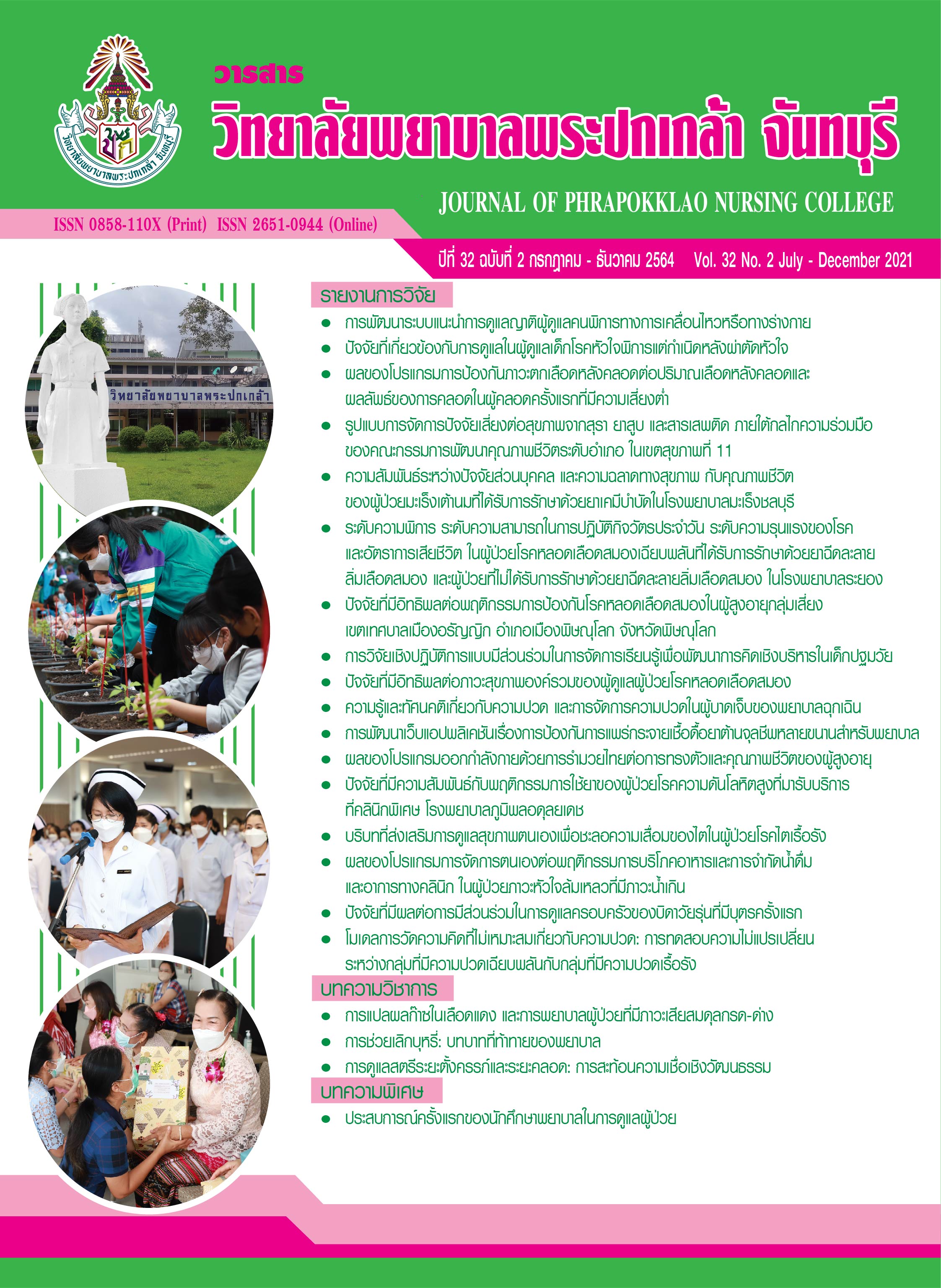Smoking Cessation Assistance: Nurses’ Challenging Roles
Keywords:
Cigarette, Smoking cessation assistance, Nurses’ rolesAbstract
Non-communicable disease (NCD) patients are increasing in the global health system. Smoking is a factor that causes NCDs. When the body is exposed to cigarette smoke, it gets toxins such as nicotine, tar, hydrogen cyanide, ammonia, etc. These toxins cause NCDs especially chronic obstructive pulmonary disease, lung cancer, stroke, cardiovascular disease, and diabetes mellitus. Each year, the public sector needs to afford a big expense for care of smoking-related NCD patients. Nurses, as healthcare personnel in healthcare system, should realize the dangers of smoking and play an important role in smoking cessation assistance in order to reduce the illness, complications, and disabilities among people. In addition, nurses need to provide health knowledge regarding the disadvantage of smoking in order to avert the new smokers. The principle that nurses should apply for smoking cessation assistance is the 5A 5R principle: the 5A principle includes Ask, Assess, Advise, Assist, and Arrange to follow up; and the 5R principle consists of Relevant, Risk, Reward, Roadblock, and Repetition. However, the smoking cessation assistance approach should be suitable for the readiness level to quit smoking of the individual.
References
ปิยะสกล สกลสัตยาทร. (2561). คนไทยตายด้วยโรค NCDs ชั่วโมงละ 37 คน เร่งป้องกัน-ควบคุมไม่ให้เกิดภาวะแทรกซ้อน. สืบค้นจาก https://www.hfocus.org/content/2018/08/16157
ศูนย์วิจัยและจัดการความรู้เพื่อการควบคุมยาสูบ มหาวิทยาลัยมหิดล. (2561). รายงานสถิติการบริโภคยาสูบของประเทศไทย พ.ศ. 2561. กรุงเทพฯ: เจริญดีมั่นคงการพิมพ์.
สุนิดา ปรีชาวงษ์. (2556). การประเมินผลการให้บริการเลิกบุหรี่: ตัวชี้วัดผลลัพธ์. วารสารพยาบาลศาสตร์และสุขภาพ, 36(2), 132–139.
สุนิดา ปรีชาวงษ์, ฟอระดี นุชส่งสิน, และศิริวรรณ พิทยรังสฤษฏ์. (2558). การทบทวนวรรณกรรมเรื่องประสิทธิผลของการให้บริการช่วยเลิกบุหรี่ในผู้ป่วยโรคเรื้อรัง. วารสารสาธารณสุขศาสตร์, 45(3), 324–333.
สุนิดา ปรีชาวงษ์, วิกุล วิสาลเสสถ์, ปทุมรัตน์ เกตุเล็ก, และยมฤดี เธียรโชติ. (2560). การให้บริการเลิกบุหรี่ในกระบวนการคัดกรองกลุ่มโรคไม่ติดต่อ. วารสารพยาบาลศาสตร์ จุฬาลงกรณ์มหาวิทยาลัย, 29(1), 1–10.
อรรถเกียรติ กาญจนพิบูลวงศ์, ภาณุวัฒน์ คำวังสง่า, และสุธิดา แก้วทา. (บ.ก.). (2563). รายงานสถานการณ์โรค NCDs เบาหวาน ความดันโลหิตสูง และปัจจัยเสี่ยงที่เกี่ยวข้อง พ.ศ. 2562. กรุงเทพฯ: อักษรกราฟฟิค แอนด์ ดีไซน์.
อรสา พันธ์ภักดี. (2555). แนวปฏิบัติการพยาบาลเพื่อช่วยเลิกบุหรี่: คู่มือการให้คำแนะนำการช่วยเลิกบุหรี่สู่งานประจำ. กรุงเทพฯ: อัพทรูยู ครีเอทนิว.
Barth, J., Critchley, J. A., & Bengel, J. (2009). Psychosocial interventions for smoking cessation in patients with coronary heart disease (Review). Retrieved from https://www.ncsct.co.uk/usr/pub/psychosocial-interventions-for-smoking-cessation-in-patients-with-coronary-heart-disease.pdf
Heatherton, T. F., Kozlowski, L. T., Frecker, R. C., & Fagerstrom, K. O. (1991). The Fagerstrom Test for Nicotine Dependence: A revision of the Fagerstrom Tolerance Questionnaire. British Journal of Addiction, 86(9), 1119–1127. doi:10.1111/j.1360-0443.1991.tb01879.x
Heatherton, T. F., Kozlowski, L. T., Frecker, R. C., Rickert, W., & Robinson, J. (1989). Measuring the heaviness of smoking: Using self-reported time to the first cigarette of the day and number of cigarettes smoked per day. British Journal of Addiction, 84(7), 791–799. doi:10.1111/j.1360-0443.1989.tb03059.x
Prochaska, J. O., & DiClemente, C. C. (1983). Stages and processes of self-change of smoking: Toward an integrative model of change. Journal of Consulting and Clinical Psychology, 51(3), 390–395. doi:10.1037//0022-006x.51.3.390
Raja, M., Garg, A., Yadav, P., Jha, K., & Handa, S. (2016). Diagnostic methods for detection of cotinine level in tobacco users: A review. Journal of Clinical and Diagnostic Research, 10(3), 4–6. doi:10.7860/JCDR/2016/17360.7423
World Health Organization. (2008). WHO report on the global tobacco epidemic, 2008: the MPOWER package. Geneva: Author.
World Health Organization. (2013). Action plan for the prevention and control of noncommunicable diseases in South-East Asia, 2013–2020. Retrieved from https://apps.who.int/iris/handle/10665/333817
World Health Organization. (2017). WHO report on the global tobacco epidemic, 2017: Monitoring tobacco use and prevention policies. Geneva: Author.
Downloads
Published
How to Cite
Issue
Section
License
เนื้อความ ข้อมูล และรายการอ้างอิงที่ผู้เขียนใช้ในการเขียนบทความเพื่อลงตีพิมพ์ในวารสารวิทยาลัยพยาบาลพระปกเกล้า จันทบุรี ถือเป็นความคิดเห็นและความรับผิดชอบของผู้เขียน คณะผู้จัดทำวารสารไม่จำเป็นต้องเห็นพ้องด้วยหรือร่วมรับผิดชอบ
บทความที่ได้รับการลงตีพิมพ์ในวารสารวิทยาลัยพยาบาลพระปกเกล้า จันทบุรี ถือเป็นลิขสิทธิ์ของวารสารวิทยาลัยพยาบาลพระปกเกล้า จันทบุรี หากหน่วยงานหรือบุคคลใดต้องการนำส่วนหนึ่งหรือทั้งหมดของบทความไปเผยแพร่ต่อเพื่อวัตถุประสงค์ใด ๆ จะต้องได้รับอนุญาตจากบรรณาธิการวารสารก่อน



